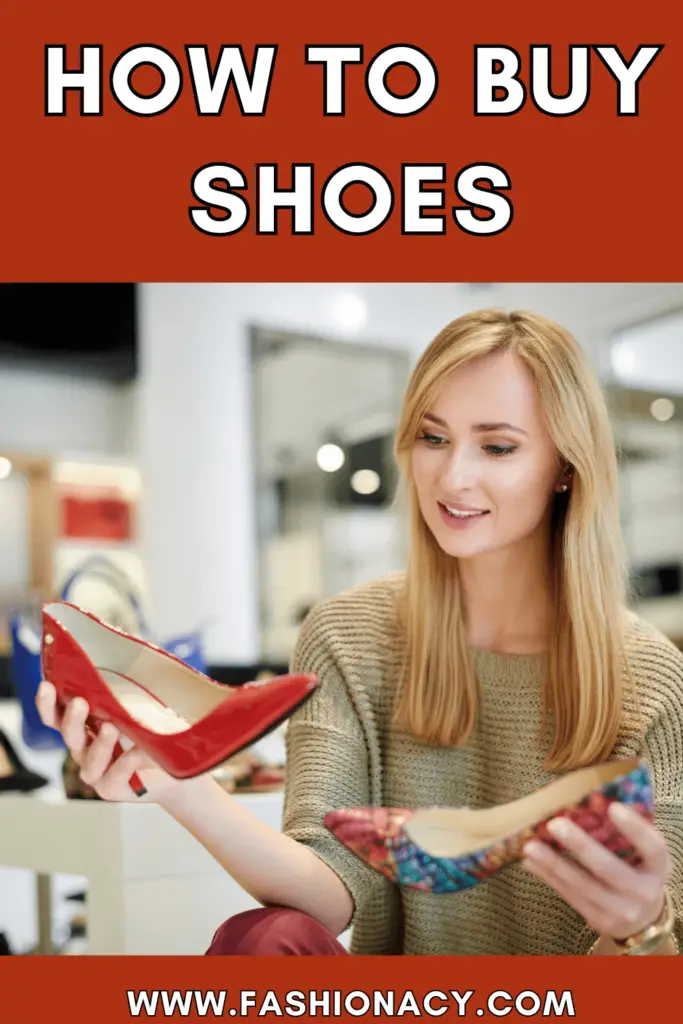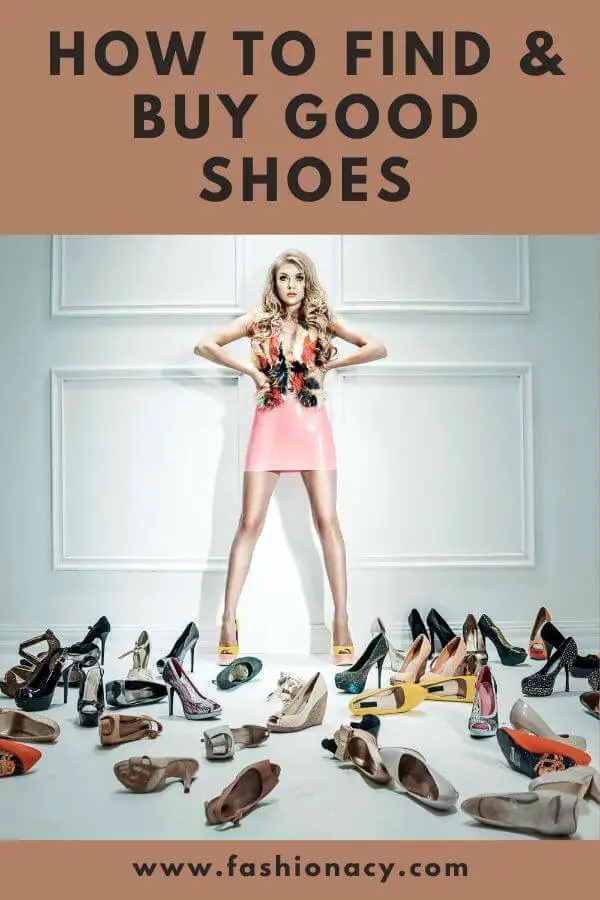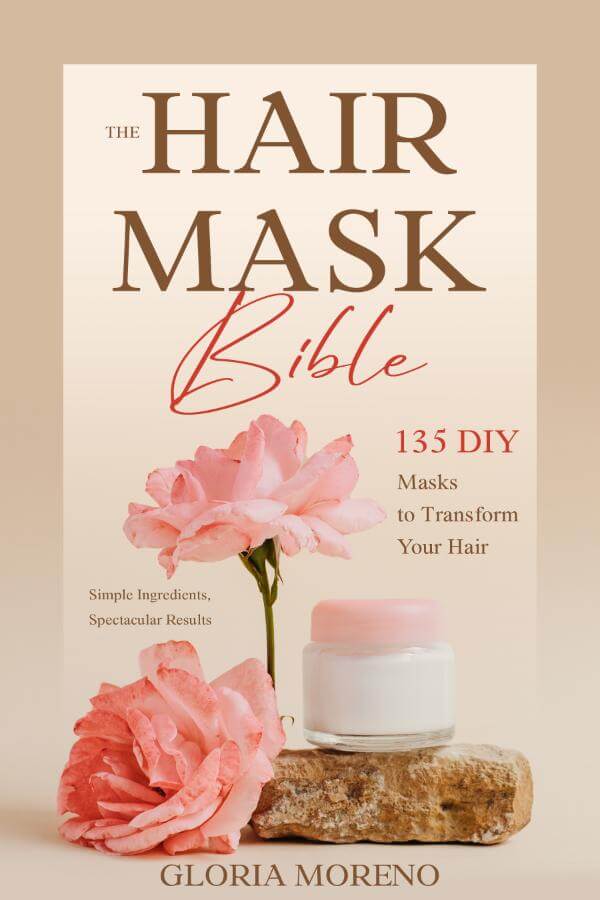
Sad to say, the price and brand of shoes you buy do not indicate whether or not you are getting decent quality.
When shopping for shoes, there are a few aspects you can easily pay attention to that will save you a lot of time, discomfort, and regret.
The materials as well as the construction are quite important.
You will also learn some shoe shopping tips at the end of this post, which you may or may not be aware of. It isn’t always clear.
Let’s find out how to buy good shoes.
Material
The material is quite crucial.
Fabric, suede, which is slightly brushed leather, flat normal leather, and plastic are the most common materials used in shoes. The majority of shoes fall into one of these four groups.
The shoe will tell you everything you need to know. On one of my ballerinas, for example, it says that the outside is suede leather, the inner is leather (not suede, not hairy, but plain flat leather), and the sole is plastic.
I have handcrafted shoes with leather uppers, leather inside, and leather soles, according to the inside label.
Essentially, the shoe will inform you.
Depending on how you look at it, each material might be excellent or terrible.
Leather
Animal skin is used to make leather. If you’re a vegan or vegetarian, this is an obvious case against leather.
It is sun and water sensitive. Because it is such a noble material, it must be prepared before being utilized in shoes. It becomes more expensive and premium as a result of this.
It’s soft and flexible, and as you use the shoes, it becomes more and more comfy. It’s also biodegradable and fairly breathable.
All leathers are not created equal. There’s leather and then there’s leather. Depending on where it’s made and how it’s made.
It’s probably of greater quality if the leather is very thin, flexible, and supple.
Also, if you notice a small scratch on a shoe when trying it on in a store and the scratch is the same color as the leather’s surface, that’s a positive sign. This indicates that the skin has been appropriately prepped. That’s a greater level of quality.
If you have a scratch on your shoes later, it would be much easier to just fix it with transparent shoe cream rather than having to search for a tinted cream that matches the color of your shoes.
Plastic
Polyurethane, or P.U., is the formal name.
It is far less expensive, which is why many lower-cost brands will employ it in their shoe production.
It’s extremely tough, even tougher than leather, but it’s so tough that it’s not biodegradable. Leather takes about 50 years to decompose. P.U. will require 500 years.
It is not breathable. It’s also UV-sensitive, so if you keep the shoes out in the sun, the color may fade or change.
When you hear that shoes are made of vegan leather, it’s actually P.U. that has been processed to look like leather, but it’s actually plastic.
Embellishments
To wrap off our discussion of materials, let’s take a quick look at ribbons, embellishments, and other items that are normally sewed on top of the shoe as decorative features.
Let’s imagine the upper half of the front is made of leather, with ribbons or beads sewed into the leather. Because the leather is flexible, it will stretch and then bounce back into position.
The beading on top is stiffly sewn onto it. This will cause the sewing holes to expand over time. It’s possible that you’ll end up having holes in your leather.
All of the things put on top will stiffen everything, making your shoes a lot less comfortable.
I’m not a big fan of embellishments and extras on top of shoes. That can be found in high-end shoe stores, low-cost shoe stores, and even super-high-end designer shoes. That does not strike me as a sign of quality or durability.
Construction
Let’s move on to the shoe’s construction, which is another crucial component.
The upper, both outside and inside, is vital; the sole, the heel (where it is put counts a lot), and the arch are all important. The higher the heels, the more critical this is.
Let’s take a closer look at each of those components.
Stitching
Typically, the upper and the sole are made separately and then glued or stitched together. If done correctly, both ways can be beneficial.
If you see stitches all around, then the thread of the stitches should be waxed. That is very important. If you scratch a little with your nail and don’t see any small hairs coming out, you can be confident. That’s a positive indicator. If, in a sense, the thread remains compact and flat.
Wax increases the thread’s durability by protecting it and making the seam watertight.
Gluing
If the sole is glued rather than stitched, take the time to inspect all of the edges before purchasing the shoes.
There should be no glue whatsoever. If you see visible glue someplace, it means the thing was made very cheaply. Take your time to examine both shoes from every angle.
The salesperson will think you’re strange, which is fine because you know what you’re doing:-)
All of the edges should be perfect.
If you have edge paint, and the edges were painted to match the color of the heel and rubber sole, this edge paint should likewise be flawless.

Soles
I have a pair of leather-soled shoes. They’re absorbing a lot of the items I trod on, they’re filthy, and they’re starting to get eaten up by all the little sand, glass, and stone fragments I stepped on. The soles are beginning to wear out.
That’s why a rubber sole is my preferred choice. It’s less slick, and you could theoretically replace the rubber sole as it wears out without causing damage to the leather.
Any shoe repair business may replace a leather sole with a rubber sole if you buy shoes with leather soles. You may simply replace the rubber sole on a regular basis.
Heels
The heel’s position under the shoe is the next issue to consider.
The entire heel of the shoe should be in the center of the foot’s heel. That is how the heel of a shoe should be placed. The part that is supported on the floor should really be under your heel.
The heel of some shoes, particularly ankle boots, can go totally vertically if they’re cheap and badly made. That’s not a good sign. That’s not how foot works; that’s terrible construction.
Arch
The arch is crucial, especially when wearing high heels. It should be contoured to your foot’s natural curvature.
The foot should be able to naturally lie in it and feel at ease, with the entire surface serving as a point of touch.
You might think that ballerinas have no arch since their bodies are perfectly flat. They can’t be comfortable by definition. You’ll need to wear them with an insole inside to compensate for the shoe’s flatness. Otherwise, it will never operate with your foot’s natural arch.
Lining
A whole lining should be visible within the shoe.
If you stick your fingers inside or glance inside, you should be able to see that the lining extends all the way to the top. It has a complete lining.
But it’s not ideal if it appears to be lined but when you peek inside to the front, you discover it stops in the center. Every time you take a step, the front part of your foot contacts the heated earth. Cheap.
Cushioning
The heel and the front half of the foot, where the balls of the foot are, are the two main places that are shocked every time you take a step.
A cushion is required in good shoes. I have shoes with a small cushion under the heel, but they don’t have one in the front. So that’s half of the job done.
Helpful Tips
Here are some helpful hints that I believe not everyone is aware of.
Always try on shoes when your feet are swollen. That is, at the end of the day or on particularly hot days. This allows you to view the full extent of your feet’s expansion. They are compact in the morning and expand by up to half their original size over the day.
Another thing to check before you buy is whether the shoe is flexible sideways by pressing on the sides. That’s a sign of comfort. If the shoe is light or flat, this is very critical.
Use a waterproof spray to protect your shoes. It’s not a gimmick; it’s quite useful. Do it as soon as you get your shoes and before you put them on for the first time. Every now and then, do it a couple of times during the year. It should be done every time they become wet. It preserves the surface, makes it easier to clean, and extends the life of the surface.
Do you remember the papers that come with your shoes when you buy them? That’s fantastic. That’s something you should keep. Put the paper in your shoes when you store them, especially if they’re leather or boots with a shape that needs to stay the same. You’ll be able to keep the shape for much longer.



